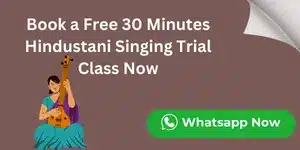- Musical Characteristics of Raag Bhairavi
- What are the Notes Used in Raag Bhairavi?
- Raag Bhairavi – Swar Notations
- Raag Bhairavi Bandish : Jaye Tu Man Guru Charan Sharan
- Variants of Raag Bhairavi
- How Does Bhairavi Create a Devotional Atmosphere?
- How is Bhairavi Different from Bhairav?
- Popular Bollywood Songs in Raag Bhairavi
- How to Identify Raag Bhairavi in a Song?
- FAQs
Raag Bhairavi, named after the primordial Mother Goddess herself, is a Hindustani Classical heptatonic (Sampurna) raga of Bhairavi thaat. The word Bhairavi is derived from one of the eight forms of the Devi born in the burial grounds.
It is often referred to as the Queen of morning Ragas which produces a rich and devotional atmosphere especially suitable for the genres of Bhajan and light classical form of Thumri.
Musical Characteristics of Raag Bhairavi
Since Raga Bhairavi is an ocean of immense possibilities, the melodic combinations can include all the twelve notes rendered with skill. The soft (komal) notes and their smooth rendering with pleasing touches – Khatke, Jhatke and Murkiyan is simply mesmerizing. Bhairavi is also one of the ten fundamental Hindustani thaats proposed by the great Sangeetagya Pandit Vishnu Narayan Bhatkhande. Its swara-set hews to the 8th Carnatic melakarta, Hanumatodi: S r g M P d n.
What are the Notes Used in Raag Bhairavi?
To begin with Re, Ga, Dha, Ni are komal and Ma, shudh in Raag Bhairavi aaroh avroh. The Rishabh and Dhaivat used in this Raga oscillate very often and are strongly recommended to make its mood intense. Rishabh and Pancham are occasionally skipped in Aaroh like: S G m d P or G m d N S’ and Gandhaar is sung with a shake which is a unique characteristic of Bhairavi. In Avroh, Rishabh and Pancham are Deergh like S’ N d P or P m G m r r S. In Avroh, Gandhaar is skipped like: G m r S. Madhyam is an important note (Vadi Swar).
The nyasa swaras are S, g and P; in addition, M and d are often sought for elongation. Care has to be observed in the treatment of d so as to keep Asawari touch at bay. As to the vadi, there is no prevailing consensus. Traditionally, M has been considered for the role but in recent times the accent has shifted to other swaras.
Raag Bhairavi – Swar Notations
You can refer to the following table to understand the basics of the raga:
| Swaras | Rishabh, Gandhar Dhaivat, Nishad komal. Madhyama Shuddha. |
| Jati | Sampurna-Sampurna |
| Thaat | Bhairavi |
| Vadi / Samvaadi | Madhyam / Shadaj |
| Ideal time to sing | Early Morning / First Prahar of the day |
| Vishranti Sthan | S; m; P; – S’; P; m; |
| Mukhya-ang | g S r S; g m P; d m d n S’; r’ S’ d P g m r S |
| Aaroh-Avroh | S r g m P d n S’; S’ n d P m g r S |
Raag Bhairavi Bandish : Jaye Tu Man Guru Charan Sharan
Refer to the following Bandish to catch the drift of the Raga:
STHAYI
Jaye Tu Man Guru Charan Sharan -2
Ek Bhav Dhar Antar Mo Man -2
ANTARA
Joi Javat Jan Sadguru Ke Sharan -2
Va Ko Harat Chatur Bhav Bandhan
*Note: The Bandish is sung in Teen Taal – Madhya laya.*
Variants of Raag Bhairavi
Independent of its history, Raga Bhairavi is a beautiful raga offering plenty of scope to improvise. Although Bhairavi is a major league raga, it stands apart from other ragas of like stature in one important aspect: its use of all 12 swaras, a signal feature of the Bhairavi praxis. The five Vivadi swaras that are not members of the original set are implemented judiciously, without injury to the nature of the Raga. In this latter form the melody instantiated is often termed as “Mishra Bhairavi.
The rich culture of Bhairavi has produced many newly explored shades of the Raga. Bhairavi with no deviations from the prescribed notes and movements is known as Shuddha Bhairavi whereas a variation known as Sindhu Bhairavi retains all the mannerisms of the parent but with Rishabh augmented to its shuddha shade. These days Sindhu Bhairavi is sung with both Rishabhs and both Dhaivats. Other variants such as Jangla Bhairavi, Kasuri Bhairavi,etc also exist. These are relatively minor offshoots originating from the Bhairavi stem , all can be located under the “Mishra Bhairavi” rubric.
Dhrupad and Dhamar compositions abound in Bhairavi. Khayal servings usually come in the form of Druta compositions. Bhairavi finds extensive applications in auxiliary genres such as taranna, tappa and thumri. Vilambit Khayal presentations are rare. The Raga affords a wide compass for rumination, and numerous melodic templates with which to develop its motif have evolved.
How Does Bhairavi Create a Devotional Atmosphere?
Sanctitude of Raag Bhairavi Mood
To some people, Raga Bhairavi feels like ‘MUKTI’ (liberation). When someone goes deep into this Raga, the urge to listen or sing any other Raga suppresses for a longer period of time.This Raga has the capability to make someone feel enlightened and make all their desires fade away. A pleasant sobering atmosphere full of love and piety is created and one feels so close to the Supreme.
Bhairavi is traditionally an early morning raga as per the Indian time classification of Ragas. In the past, when time restrictions of a public concert were rare, great musicians of those days often sang through the night.
How is Bhairavi Different from Bhairav?
Below are the differences in Bhairavi and Bhairav raag’s characteristics.
| Aspect | Bhairavi | Bhairav |
| Thaat | Bhairavi | Bhairav |
| Aroha | Sa Re Ga Ma Pa Dha Ni Sa | Sa Re Ga Ma Pa Dha Ni Sa |
| Avroha | Sa Ni Dha Pa Ma Ga Re Sa | Sa Ni Dha Pa Ma Ga Re Sa |
| Samay | Morning | Early morning |
| Swar variations | Re, Gha, Dha , Ni komal and Ma Shudh | Re, Dha komal and rest of swars shudh |
| Vadi | Ma | Dha |
| Samvadi | Sa | Re |
| Jati | Sampurna- Sampurna | Sampurna- Sampurna |
| Mood | Devotional, Romantic, Serne | Serious, Meditative, Austere. |
Popular Bollywood Songs in Raag Bhairavi
Bhairavi has been cultivated extravagantly by the Hindi film music composers. Many of the lasting creations of the 20th Century have their roots in this raga. The distinction between ‘light’ and ‘classical’ is largely moot in this case since a good Bhairavi rendition is seen as “Bhairavi” without regard to genre or source.
Many Indians growing up during the 1980s and 1990s will instantly recognize Raga Bhairavi as it is the dominant note in the popular Doordarshan video “Mile Sur Mera Tumhara”.
It was in 1935 that the first song in a Hindi movie was composed using Raga Bhairavi. Since then, it has retained its popularity among music composers of Bollywood. It has not only been used for songs that are identified with classical music and are loved by connoisseurs of classical music, but has also been used for composing mainstream popular songs that cater to the masses. Many such numbers are based on Raga Bhairavi with a lot of variations to suit the popular taste.
How to Identify Raag Bhairavi in a Song?
One of the reasons for the popularity of Raga Bhairavi in composing popular numbers is the character of the Raga itself. The concept of understanding ‘Raga Bhava’ of Bhairavi is one of the essential skills needed. Look for phrases or the signature movements including pakad like Ga Ma Pa Dha Ni Dha Pa or Sa Ni Dha Pa Ma Ga Re or Ga Ma Pa, Ga Re Sa gives this raga its identity.
It has a soft, peaceful, flowing character that can easily fit into all kinds of compositions depicting different feelings. It has been used to depict distress as well as ecstasy ,and yet , its primary character is rather peaceful, making it a good choice for introspective numbers. This way , it covers an entire range of emotions that can be expressed using it, making it a popular tool in the hands of music composers.
Few of the popular compositions that are based on Raag Bhairavi notes are listed below:
Few more songs in Raag Bhairavi are given below:
- ‘Dost dost na raha pyar pyar na raha’ from the movie SANGAM.
- ‘Mere desh ki dharti sona ugle’ from the movie UPKAR.
- ‘Bhor bhaye panghat pe’ from the movie SATYAM SHIVAM SUNDARAM.
So fanatically loved and widely embraced is Raga Bhairavi that its elemental imprint is firmly fixed in the mind of even the untutored Rasikas (Indian Classical Music enthusiasts).
New to hindustani music and want to explore more raagas? Start your music joureny with Musicmaster Hindustani music classes. Book your free demo now.
FAQs
When to sing raag bhairavi?
Raag Bhairavi should be sung during the Dawn.
What are the notes in Raag Bhairavi?
Re, Ga, Dha, Ni are komal and Ma, shudh in Raag Bhairavi.
What are the characteristics of Bhairavi raga?
Raag bhairavi notes are all komal except Ma, Pa and Sa, is sung in the morning and often in the semi classical genre.
What is the parent raga of Bhairavi?
Bhairavi is the parent raga of Bhairavi.
What is the Speciality of Raag Bhairavi?
Speciality of Raag Bhairavi lies in its emotional depth, versatility and its use in spiritual and light classical compositions.
How to play Raag Bhairavi on harmonium?
Start on Sa and proceed with komal Re, Ga, Dha, Ni and sudh Ma. Practice raag bhairav notation including aroh and avroh to play Raag Bhairavi notes on harmonium.
How is Raag Bhairavi different from other ragas?
Songs based on Raga Bhairavi differ on the basis of swaras used(all komal except Ma), time of performance and its versatile nature.
Can Raag Bhairavi be performed in Carnatic music?
Yes, Raag Bhairavi can be performed in Carnatic music.
Related blog: Raag Bhimpalasi

































